BRING AVENGERS TO THE FIGHT: HMMWVS FOR AIRBORNE FORCE SHOCK ACTION
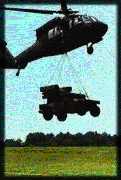
PANAMA, 1989
Robert W. Black, in his book, Rangers in World War II said the following about the disastrous Dieppe Raid where commandos assaulted fortified positions with little fire support other than what they carried in their hands;
The loss of the M551 Sheridan light tank and the cancellation of its replacement, the M8 Armored Gun System from the ranks of the U.S. Army Airborne make it vital that we field some sort of ground vehicle with building/bunker-blasting effects since these were decisive in our victory over Panama in 1989 and conspicuously absent in 1993 Somalia. The world moves by the speed of AIR and is urbanizing rapidly. One way to do this is by insuring that XVIII Airborne Corps Air Defense Artillery (ADA) units get deployed along with early entry parachute-infantry forces of the 82nd Airborne Division to act in a ground attack role using 2.75" Hydra-70 rockets instead of Stinger Surface-to-Air Missiles (SAMs) and the integral .50 caliber heavy machine gun on the Avenger HMMWV weapon system.
Thanks to the suggestions and dedication of visionary Marine Captain Carlton Meyer, the Avenger HMMWV 4x4 vehicle has just been proven capable of firing the Hydra-70 family of 2.75" pods in place of Stinger SAM pods (scroll down to second article at the bottom or click this hyperlink). Such advances in ADA technology and war-fighting capabilities are reported regularly in the excellent ADA branch, journal, ADA Magazine online. The Hydra-70 family has been increased in its variety and lethality (Anti-personnel flechette "beehive" rounds, smoke etc) and is currently used by XVIII Airborne Corps Kiowa Warrior and Apache helicopter gunships for close-air-support of Paratroopers.
"At 20 0038 Dec, a military police (MP) patrol engaged a gate guard at the Naval Infantry Complex, Coco Solo. Shortly thereafter C/4-17th Inf broadcast surrender demands which were answered by return fire from the headquarters building. As a show of force, the attached Vulcans were leveled and fired sustained 10-round bursts, tearing through walls and dispersing the defenders. A surrender offer was again announced over the loudspeakers which was answered by return fire from the PDF. As the volume of fire being returned by the PDF continued to increase, a second volley was fired by the Vulcans. The PDF began screaming their surrender and shouting to stop firing.
U.S. Army Center for Lessons Learned: Operation Just Cause Fire Support
"68% of the 4,963 Canadian troops were casualties and 913 were killed outright.... On August 19, 1942, the Canadians did all that flesh could do against fire, but has been proven on battlefield after battlefield against an aroused, entrenched enemy, COURAGE IS NOT A SUBSTITUTE FOR FIRE SUPPORT..."



HYDRA-70 Warheads can be categorized into two areas. Unitary warheads are fitted with impact detonating warheads. Cargo warheads, with airburst range setable or fixed stand-off fuzes, utilize the "wall-in-space" concept. The "wall-in-space" concept provides an extremely large increase in effectiveness and virtually eliminates range-to-target errors due to variations in launcher/helicopter pitch angles during launch. The M439 Fuze is remotely set from the aircraft with time (range) to the target data. After firing, the initial forward motion of the rocket begins fuze functioning at the computer-determined time (at a point slightly before and above the target area), the M439 Fuze initiates the expulsion charge. The submunitions (SMs) are ejected, and each Ram Air Decelerator (RAD) inflates. This separates the SMs, starts the arming sequence, and causes each SM to enter into a near vertical descent into the target area. Similarly, the payload of the M267 is discharged to deploy the three M75 Practice SMs. There are two launchers, a 7-shot rocket launcher and a 19-shot launcher.
Unitary Warheads
Cargo Warheads
M261 MPSM
Since, often the enemy aircraft threat has been reduced to nil by U.S. Air Force Air Supremacy derived from F-15/16 and Stealth F-22 Raptor fighters it is smart war fighting to exploit the ADA assets within the Airborne Corps in a ground attack role to give needed SHOCK ACTION against hard and area targets standing in the way of the Paratrooper advance. The 2.75" rocket is already in the logistics "pipeline" of the air assets of the XVIII Airborne Corps so they could be easily resupplied to ADA Avenger HMMWVs from the same Forward, Arming and Refueling Points (FAARPs) that are set up for attack helicopters of the Corps. Details of the 6 firing unit organization of the Avenger Platoon are described in
FM 44-44 Avenger Platoon Operations
Whereas a helicopter's time on station is limited severely by fuel supply and can be thwarted by massed enemy small arms/RPG fire as encountered in Somalia, 2.75" rocket pods on a ground Avenger HMMWV can stay on the scene and devastate the enemy attempting to fight behind urban cover. The Avenger's .50 caliber heavy machine gun can also protect the vehicle/crew as it maneuvers into rocket firing position by suppressive fires. The Avenger's small size and nimbleness compared to the 70-ton M1 Abrams heavy tank (unavailable for airdrop) and its ripple-rocket fire capability is a great asset getting into and out of firing positions to clobber the enemy in narrow city streets like the tiny tracked M50 Ontos ripple-fired its six 106mm RRs in Hue city, Vietnam.
Avengers with their Forward Looking Infared (FLIR) and videotaping capabilities are being used in Bosnia now to provide surveillance and early warning to U.S. Army peacekeeper units. Escort Airborne infantry to clear the way for the Avenger to get into firing positions in a close fight can be supplied by 11-ton, air-droppable M113A3 Gavin Armored Personnel Carriers (APCs) with RPG/small arms fire resistant applique' armor from Airborne Chemical or Combat Engineer units.
ADA UNITS IN GROUND ATTACK ROLES
Using ADA assets for ground attack capabilities is not a new idea: German General Field Marshall Erwin Rommel made his mark in WWII at the Battle for France when he defeated a British armored counter-attack at Arras by directing his 88mm Anti-Aircraft guns at British "Mathilda" infantry tanks leading the assault. The "88" became a "thorn" in the Allies' side for the rest of the war after it was mounted on tanks, the legendary Tiger I and II, Panthers as well as knocking down bombers at high altitude and being used as an expedient field gun.
In Vietnam, M42 "Duster" vehicles with twin 40mm cannon successfully protected road convoys from enemy ambushes using their high rate of fire and explosive shell effects. Later, M113 APCs equipped with 20mm Gatling cannons in use by U.S. Army ADA units (M163 "Vulcan" systems) were used experimentally with devastating effects to protect convoys from road ambushes. ADA units were critical to successfully defending the Khe Sanh firebase from being over-run. Quad .50 caliber machine guns were re-claimed from the National Guard and mounted on trucks, so its not unrealistic to ask that National Guard M113A3s being replaced by Bradleys could also be re-claimed. M42 Duster light armored vehicles used their twin 40mm Bofors cannon to ward off enemy attacks from besieged firebases like at Khe Sanh. These systems no longer in ADA use could be utilized by U.S. Army light forces for shock action--especially the M163 Vulcans which should be upgraded to "A3" configuration with RISE powerpack and external fuel cells, applique' armor resistant to RPG, heavy machine guns, cannon fire or the 20mm Vulcan cannon retrofitted to reclaimed National Guard M113A3s. Since the RAH-66 Comanche is going to use 20mm cannon, why not retrofit unused Vulcan cannon to Avenger systems to upgrade the .50 cal HMG as Cpt. Meyer suggests?
As described at the top, towed 20mm Vulcan ADA systems were key in gaining the surrender of enemy troops by firepower demonstrations in Panama, and should be exploited whenver possible via NG towed Vulcan units. However, in the mean time, the 2.75" Hydra-70 rocket capability is something we can do today with existing active duty Avenger ADA units quickly.
Other Allies are using wheeled vehicles to shoot rockets at ground targets--- the South African mine protected 4x4 wheeled armored vehicles bought by the U.S. Army for Bosnia can be fitted with rockets for ground SHOCK ACTION (see above). We had best do something to make up for the loss of the superb M551 Sheridan light tank!
Using rockets on wheeled vehicles is also not new, Tanker Forum commentator, Chris Werb writes about "Jeep rockets":
The best candidate for your jeep launcher is the T45 which was also fitted to the M24 light tank and LVT(A)4 as well as to some International 1 ton 4x4 trucks. The jeep carried two launchers each loaded with 14 M8 series 4.5" rockets. It was fixed in traverse and elevated up to 35 degrees. The data I have mixes versions but the rocket weighed in at approx 17.5kg, had a 1.95kg HE filling and a range of 4209 metres.
The most amazing WW2 launcher must have been the T103 which launced a 250 or 500lb aircraft bomb powered by three T22 rocket motors combined to form a T13 jet propulsion unit. The launcher was a modified 105mm howitzer carriage fitted with a V-shaped trough in lieu of the cannon. It used the panoramic sight from the 75mm pack howitzer and actually saw service in the Pacific theatre in the closing months of WW-2 and I have a picture of it in action."
Its noteworthy that like the tracked 105mm howitzer carriage used above, the Bradley Linebacker ADA vehicle in heavy units could have its Stinger SAM pods replaced with 2.75" Hydra-70 rockets for ground attack, SHOCK ACTION since its "pop-gun" 25mm cannon is weak on building destructive effects.
"Securing and/or clearing a built-up area is very manpower-intensive. A city block in Panama City often included 50 buildings, many of them multiple storied, to include high rises. Most buildings were constructed of concrete reinforced with rebar."
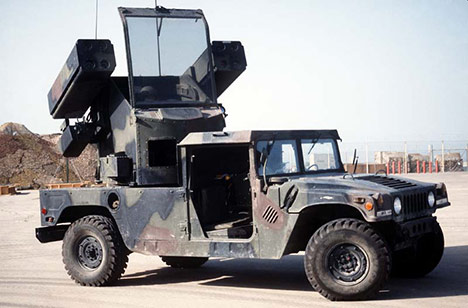
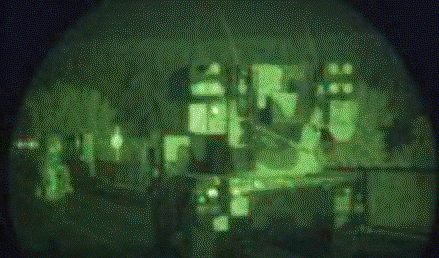


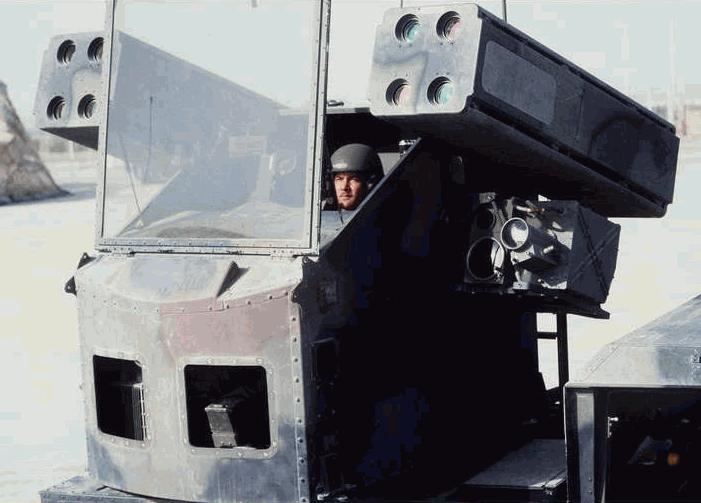
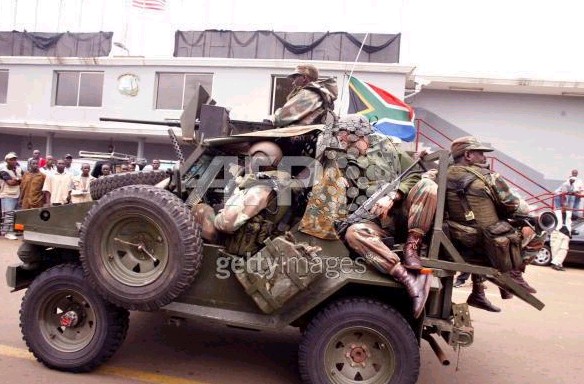
"The USA actually deployed a surprising array of surface to surface rockets on a wide variety of platforms in the latter stages of WW2. The best source I have seen on these is Peter Chamberlain and Terry Gander's 'Mortars and Rockets' in the WW2 factfile series ISBN 0 356 08081 1
U.S. Army Lesson Learned: Operation Just Cause Building Clearing
"The 25mm gun produces its best urban target results when fired perpindicular to a hard surface (zero obliquity). In combat in built-up areas however, finding a covered firing position permitting low obliquity firing is unlikely unless the streets and gaps between buildings are wide. Most shots impact the target at an angle which normally reduces penetration. With the armor-piercing, discarding sabot with tracer (APDS-T) round, an angle of obliquity of up to 20 degrees can actually improve breaching. The rounds tend to dislodge more wall material for each shot, but do not penetrate as deeply into the structure"IN 0531 Combat in built-up areas"Reinforced concrete walls which are 12 to 20 inches thick, present problems for the 25mm gun when trying to create breech holes. It is relatively easy to penetrate, fractures, and clear away the concrete, but the reinforcing rods remain in place"

AVENGER HMMWV BEING READIED FOR LOW VELOCITY AIRDROP
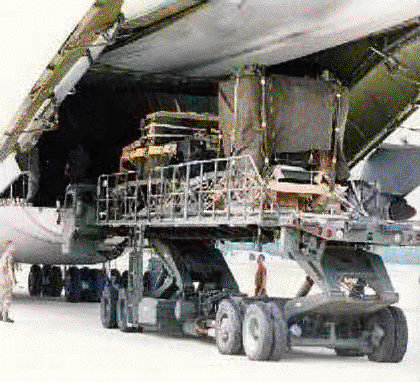
Photo courtesy of U.S. Army Airborne Special Operations Test Board

FEEDBACK!!!
A U.S. Army G-3 war planner writes:
Great article. I have heard about the tests with Hydra-70
rockets. I have done some work on the feasibility of replacing the mortar platoons at battalion level with Avenger-Hydra systems. The MPSM rocket is the "standard" Attack helicopter rocket for all occasions. I have fired a bunch myself from Cobras. Each MPSM has nine coffee cup sized bomblets that have a shaped charge about the size of the warhead on the older LAW rocket. A wire plugs into the pod which allows a fire
control computer to set the RC-43 base fuse. I especially like the Avenger with Hydra 70 rocket pods, not only would such a weapon option provide direct fire but the "wall-space" fusing available on the M-267 Muti-Pupose Sub-mintion (MPSM) provides the commander with a very mobile alternative to mortar fire with a range of 7200 meters and a light anti-armor anti-personnel and anti-material capability. Not to mention the ability to hammer a target with 76 Rockets at once from just one vehicle.
WALL-IN-SPACE Firing Technique
The rocket is then fired and at the desired range the bombets are released via a small charge in the base of the warhead. The bomblets then deploy a drag chute each and float down near verticle on the target. Each of the nine bomblets has approximately the same bursting radius of the conventional ten pound HE warhead of Vietnam fame! If the bomblet falls on top of an armored vehicle it will penetrate a few inches of steel with its shaped charge. This RC fuse ability nearly eliminates the range problems normally associated with flat trajectory
rockets and provides them excellent "plunging" fire. The accuracy is outstanding providing you know the range to the target!
Disadvantages are that the bomblets, like all sub munitions, have a high dud rate which makes them a hazard to friendly troops that may cross over that area. And that once you fire your load it is time consuming to reload. Unless the pods are disposable and preloaded then a simple wenching system could reload 76 rounds in a couple of minutes. I'll see if I can find a copy of the old 1984 Army training film on the ground mounted MPSM rocket POD. The Army tested a trailer version.
You may not be aware that this handy RC fuse capability is also
excellent for flechette rounds! There are two new types, one with several thousand small size flechettes and one with pencil size ones for light armor. An Avenger could for example, scan a Korean Mountain side where friendly troops are receiving fire from, and Lase the ranges, then fire a "spread" of flechette rounds out to 7200 meters. Each round would explode at the optimum distance from the hill side to give the best effects. The same technique could be used to lay down a smoke screen with smoke rounds or a wall of chaff to shut down enemy counter
fire or ADA radars.
If a JAVELIN ATGM could be fiited with the same British developed anti-armor seeker head found on their anti-armored precision mortar round, then an AVENGER equipped with one 19 shot Rocket POD on one Pedistal mount and a packet of four "precision" Over the Horizon capable JAVELINS could provide a battalion commander with excellent fire support
options that also includes STINGER ADA systems....... The possibilities are awesome.
Mr. Sparks, its possiblities like the above, using currently
available technology that leads me to believe that the traditional
howitzer cannons supporting ground maneuver battalions are obsolete and extremely wasteful in terms of vehicles, manpower and mobility. An AirMech battalion could have either a self propelled 155 mm mortar battery or an AVENGER battery that can provide indirect HE, anti-armor, anti-personnel, smoke and even ADA fires! The only reluctance I have to not letting go with mortars is the economy and precision of single HE rounds and their plunging fire support so necessary to to ground maneuver. I'm not sure an AVENGER rocket option could duplicate the short range immediate suppressive fires as efficiently as a Mortar. I favor the 155mm caliber mortar because of the advantages of using the full family of sophisticated 155 mm rounds available, from COPPERHEAD, SADARM to FASCAM to ICM. Based on the weights of similar Russian sized mortars, I estimate that a self propelled 155 mm mortar with 15 rounds could be made weighing 8000 lbs. Based on perhaps on a HMMWV chassis. This large a caliber may cause significant problems with rates of fire and range which may lead to a 120 mm caliber NATO standard. In either case, I feel that an AVENGER-Rocket combination along with a precision-capable 120 mm mortar or larger is sufficient for battalion fire needs. If the battalion needs greater fire power than the T-MARS or EFOG-M batteries at higher could be at tapped. If however, the 'STRIKE' concept is used, then there should be little need for the old concept of massed howitzers firing DS for a maneuver battalion. There won't be a MMR rolling up against the defences of a battalion TF in typical 'Fulda Gap' scenario fashion."
"Mr. Sparks
Major XXXX XXXX
REDSTONE ARSENAL, Ala., (U.S. Army News Service, Feb. 19, 1998)
By Skip Vaughn--
The Avenger air defense system has proven that it can be used in a ground-to-ground role. Avenger successfully fired 2.75-inch-diameter rockets in tests conducted here at the request of the marine corps.
The Avenger, a Humvee vehicle with two pods on top, normally fires Stinger missiles at aircraft targets. One of the Stinger pods was replaced with a 2.75" rocket pod. Test firings were conducted Jan. 28-29 at Test Area 1. The 2.75" rockets were fired by remote control from a stationary Avenger.
Several target trucks, with colorful balloons, were within 600-700 meters down range. At 500 meters, the warhead deployed small darts called flechettes. "Very successful," Bill Hughes, chief engineer, said when asked about the results. "Better than we had anticipated."
Hughes proudly pointed out a rocket hole in the side of a truck after two rockets were fired the morning of Jan. 29. Paint markings on the trucks indicated where flechettes had impacted.
Sixteen rockets were fired Jan. 28, and 16 more on Jan. 29. These included both single firings and rapid ripples in which one rocket was quickly followed by another. The marines, who have Avenger overseas, had asked the Avenger program office if the system could be tested for ground capability. Last week's firings used CRV7 rockets, a Canadian version of the 2.75", and an Avenger which was on loan from the marines.
